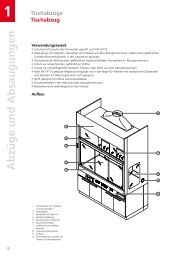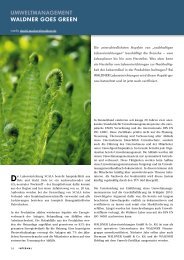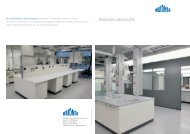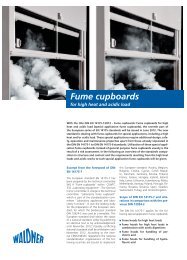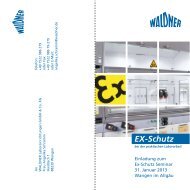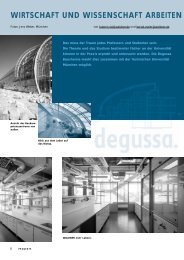WALDNER Brief - Nr. 172.pdf - Waldner Firmengruppe
WALDNER Brief - Nr. 172.pdf - Waldner Firmengruppe
WALDNER Brief - Nr. 172.pdf - Waldner Firmengruppe
Erfolgreiche ePaper selbst erstellen
Machen Sie aus Ihren PDF Publikationen ein blätterbares Flipbook mit unserer einzigartigen Google optimierten e-Paper Software.
Toothpaste for the world<br />
by alexander.wenk@waldner.de and alexander.lukas@ekato.com<br />
Bisher liegt die maximale Anlagengröße einer Zahnpastaproduktion<br />
zwischen 4.000 und 5.000 Litern Nutzvolumen, wobei<br />
der Ausstoß zwischen ca. 2.000 bis 3.000 Litern Zahnpasta<br />
pro Stunde liegt. Die zwei realisierten Produktionsanlagen mit<br />
jeweils 10.000 Liter Nutzvolumen können je nach Produktdichte<br />
12.000 bis 16.000 kg Zahnpasta pro Ansatz herstellen. Dabei<br />
liegt der Produktausstoß zwischen 6000/8000 und 8000/11.000<br />
kg pro Stunde. Dies entspricht einer Steigerung der Produktionsrate<br />
um mehr als 100% auf das Doppelte.<br />
Wir sind der festen Überzeugung, dass unser Partner – die<br />
Firma EKATO SYSTEMS GmbH – mit diesem Meilenstein neue<br />
Anlagenverkäufe bei bestehenden und neuen Kunden generieren<br />
kann und freuen uns, unsere jahrelange Partnerschaft<br />
durch Folgeaufträge hierdurch weiter auszubauen und unsere<br />
Leistungsfähigkeit sowie Termintreue in dieser auch für uns<br />
neuen Dimension erneut unter Beweis stellen zu können.<br />
I n f o - B o x<br />
Für wie viel Menschen reicht die Zahnpasta?<br />
Aus einer Tube Zahncreme mit 125 g<br />
Inhalt kann man 338 cm Zahncreme<br />
herauspressen. Eine durchschnittliche<br />
Zahnbürste für Erwachsene hat einen<br />
3 cm langen Kopf, der einer Kinderzahnbürste<br />
ist 2 cm lang. Putzt man<br />
sich 2 mal am Tag die Zähne, so<br />
reichen 125 g Zahnpasta für einen<br />
Erwachsenen für etwa 63 Tage. Ein<br />
Kind kommt circa 94 Tage damit aus.<br />
Voraussetzung dafür ist jedoch, dass<br />
der Zahnbürstenkopf vollständig mit<br />
dem Strang aus Paste behaftet wird.<br />
Ein sparsamerer Gebrauch schont das<br />
You can squeeze 338 cm of toothpaste<br />
out of a 125 g tube of toothpaste. An<br />
average adult toothbrush has a 3 cm<br />
long head, while the head of a child's<br />
toothbrush is 2 cm. If you clean your<br />
teeth twice a day, then a 125 g tube<br />
of toothpaste will last an adult around<br />
63 days and will last a child around 94<br />
days. The precondition here is, however,<br />
that the toothbrush head is fully<br />
covered with the stripe of toothpaste.<br />
More economical use of toothpaste<br />
Fertig zur Fahrt nach<br />
Schopfheim: Die Behälter<br />
sind fertig verladen und<br />
warten auf das Begleitfahrzeug<br />
der Polizei.<br />
Ready for the journey to<br />
Schopfheim: The vessels<br />
have been fully loaded and<br />
are waiting for the police<br />
escort vehicle<br />
Portmonee, jedoch nicht die Zähne.<br />
Der durchschnittliche Anlagenoutput<br />
liegt wie oben gelesen bei 8000 kg/<br />
Stunde. Dividiert man einmal die Stundenleistung<br />
durch den Tubeninhalt,<br />
0,125 kg, so ergibt sich der Wert von<br />
64.000 Tuben pro Stunde. Da 125g<br />
Zahnpasta 63 Tage ausreichen, benötigt<br />
man 2,77g pro Person pro Tag.<br />
Somit kann mit dem Stundenoutput von<br />
8.000 kg der Tagesbedarf von ca. 2,88<br />
Mio. Menschen bedient werden.<br />
For how many people is th e re e nough toothpaste?<br />
saves money but doesn't save your<br />
teeth! The average output of the plant is<br />
8,000 kg/hour, as stated above. If you<br />
divide the hourly output by the content<br />
of a tube (0.125 kg), then you arrive at<br />
a figure of 64,000 tubes per hour. As<br />
125 g of toothpaste lasts for 63 days,<br />
you need 2.77 g per person per day.<br />
The hourly output of 8,000 kg would<br />
therefore meet the daily requirement of<br />
around 2.88 million people.<br />
The Process Systems division has produced the largest<br />
global toothpaste production plant together with Schopfheim-based<br />
EKATO SYSTEMS GmbH. The plant has an hourly<br />
output of 64,000 tubes, a figure that corresponds to the daily<br />
consumption of toothpaste of almost 3 million people. The<br />
two companies achieved a milestone by using reliable scaledup<br />
technology to produce a plant designed for large-volume<br />
batch processes. <strong>Waldner</strong> produced the main component of<br />
the plant, namely the two agitator vessels.<br />
The completion of the project was a huge challenge and it<br />
was only with massive effort on all sides that the challenges<br />
could be overcome. The benchmark data on the two vessels<br />
manufactured by <strong>Waldner</strong> alone demonstrates the huge scale<br />
of the project: a weight of almost 15 tonnes per vessel, walls<br />
of up to 20 mm thick, an overall height of just under 6 metres<br />
and dimensions of 4 x 4 metres. The efforts of global companies<br />
to concentrate their production capacities on a small<br />
number of locations worldwide has also reached the personal<br />
care sector and modern production plants have to be able to<br />
manufacture large volumes with maximum flexibility.<br />
Complex production process<br />
A production plant for the manufacture of toothpaste essentially<br />
consists of a vessel with an agitator that can be evacuated,<br />
a homogeniser to homogenise the product to the required<br />
fineness of grind and different dosing systems to feed in raw<br />
materials. The liquid raw materials used are either preweighed<br />
and introduced into the vessel by vacuum suction or<br />
are dosed in by means of gravimetric methods. Powdery substances<br />
or thickeners to increase the viscosity of the mixture<br />
can be dosed in, for instance, using the integrated homogeniser,<br />
or fed into the vessel by suction through a valve in the<br />
base. The above results in the following system requirements<br />
in relation to the manufacturing process: precise dosing of<br />
large volumes of liquid ingredients, fast homogenisation of<br />
thickeners without the formation of agglomerates and inhomogeneities,<br />
rapid integration and wetting of large volumes of<br />
powders, homogeneity of product throughout the entire content<br />
of the vessel, addition of soaps without the formation of foam,<br />
rapid de-gassing of the toothpaste, homogeneous mixing of<br />
active agents, temperature control and high product yield.<br />
To date, the maximum plant size for a toothpaste manufacturing<br />
plant has been between 4,000 and 5,000 litres of<br />
effective volume, with the output lying between about 2,000 to<br />
3,000 litres of toothpaste per hour. The two production plants<br />
completed, each with an effective volume of 10,000 litres,<br />
can produce between 12,000 and 16,000 kg of toothpaste per<br />
charge, depending on the density of the product, equating to<br />
a product output of between 6,000/8,000 and 8,000/11,000 kg<br />
per hour. This corresponds to a 100% increase in the production<br />
rate, effectively a doubling of the output.<br />
Projects<br />
23





